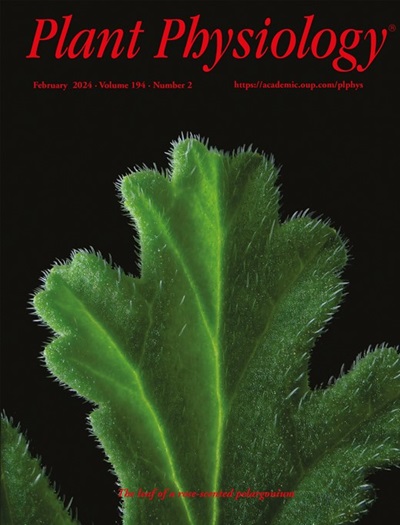转录因子基因TaMYB-D7b的一个天然等位基因是小麦缺磷的遗传标志
IF 6.5
1区 生物学
Q1 PLANT SCIENCES
引用次数: 0
摘要
磷(P)和氮(N)缺乏是全球小麦(Triticum aestivum)生产的主要产量限制因素,特别是在北美大平原南部的酸性土壤中。在本研究中,我们报道了转录因子基因TaMYB-D7是控制紫色叶颜色的一个主要数量性状位点。小麦品种‘2174’无论磷含量如何,其胚囊都呈紫色,而‘Jagger’即使磷含量限制,胚囊也不呈紫色。两个品种在TaMYB-D7中有一个氨基酸的差异:TaMYB-D7b中的Gly-50(由2174等位基因编码)和TaMYB-D7a中的Ser-50(由Jagger等位基因编码)。我们使用基因组编辑技术灭活了cv中的所有三个TaMYB7同源物。2174. 由此编辑的小麦植株在其整个生命周期中没有积累紫色色素,验证了与紫色表型相关的TaMYB-7Db的功能。在TaMYB7编辑的植物中,可能参与花青素生物合成和代谢的查尔酮合成酶2样(TaCHSL2)被显著下调,表明TaMYB7诱导了其转录。我们还发现,P上调了TaMYB7和TaCHSL2的表达,而n则下调了TaMYB7和TaCHSL2的表达。最后,我们开发了一个竞争性等位基因特异性PCR (KASP)标记,促进了TaMYB-D7b的基因分型,该标记可用于标记辅助育种。我们的研究结果为小麦养分利用效率的研究提供了新的思路。本文章由计算机程序翻译,如有差异,请以英文原文为准。
A natural allele of the transcription factor gene TaMYB-D7b is a genetic signature for phosphorus deficiency in wheat
Phosphorus (P) and nitrogen (N) deficiencies are major yield-limiting factors for wheat (Triticum aestivum) production worldwide, particularly in the acidic soils of the southern Great Plains of North America. In this study, we report that the transcription factor gene TaMYB-D7 is responsible for a major quantitative trait locus controlling purple leaf color. The wheat cultivar ‘2174’ showed purple coleoptiles regardless of P status, whereas ‘Jagger’ did not, even under P limitation. The two cultivars differed by one amino acid in TaMYB-D7: Gly-50 in TaMYB-D7b (encoded by the 2174 allele) and Ser-50 in TaMYB-D7a (encoded by the Jagger allele). We used genome editing to inactivate all three TaMYB7 homoeologs in cv. 2174. The resulting edited wheat plants did not accumulate purple pigments throughout their life cycle, validating the functions of TaMYB-7Db associated with the purple phenotype. In the TaMYB7-edited plants, chalcone synthase 2-like (TaCHSL2), which may be involved in anthocyanidin biosynthesis and metabolism, was dramatically downregulated, suggesting that TaMYB7 induces its transcription. We also discovered that the expression of TaMYB7 and TaCHSL2 was upregulated by P but downregulated by N. Lastly, we developed a Kompetitive Allele Specific PCR (KASP) marker to facilitate the genotyping of TaMYB-D7b, which can be used for marker-assisted breeding. Our results provide insight into nutrient use efficiency in wheat.
求助全文
通过发布文献求助,成功后即可免费获取论文全文。
去求助
来源期刊

Plant Physiology
生物-植物科学
CiteScore
12.20
自引率
5.40%
发文量
535
审稿时长
2.3 months
期刊介绍:
Plant Physiology® is a distinguished and highly respected journal with a rich history dating back to its establishment in 1926. It stands as a leading international publication in the field of plant biology, covering a comprehensive range of topics from the molecular and structural aspects of plant life to systems biology and ecophysiology. Recognized as the most highly cited journal in plant sciences, Plant Physiology® is a testament to its commitment to excellence and the dissemination of groundbreaking research.
As the official publication of the American Society of Plant Biologists, Plant Physiology® upholds rigorous peer-review standards, ensuring that the scientific community receives the highest quality research. The journal releases 12 issues annually, providing a steady stream of new findings and insights to its readership.
 求助内容:
求助内容: 应助结果提醒方式:
应助结果提醒方式:


